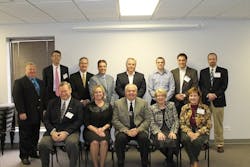Countdown to Lead-Free
The Federal Reduction of Lead in Drinking Water Act, which passed in 2011, will go into full effect on Jan. 4, 2014. It may come as a surprise that the plumbing industry, through Plumbing Manufacturers Intl. (PMI), was a primary proponent of getting this law passed, in the spirit of harmonizing regulations across the U.S.
As the deadline approaches, PMI continues to work with the U.S. Environmental Protection Agency (EPA) to clarify enforcement guidelines in order to address a number of unanswered questions. Furthermore, PMI has worked diligently to educate distributers, installers, suppliers, consumers and manufacturers about the new law.
Initiating Legislation
The story begins in 2009 in California with the introduction of AB 1953. Although many in the industry believed that the performance-based NSF/ANSI Standard 61 was a sufficient measurement tool to monitor lead levels by evaluating the quality of water flowing from the tap, PMI and the plumbing industry ultimately worked to strengthen California’s prescriptive law by helping to write language and advocating enhanced enforcement. AB 1953 set a prescriptive 0.25% lead content product requirement.
Soon other states began looking at lead regulations, too, some considering different allowable levels from the California standard. PMI successfully advocated that those states (Louisiana, Vermont and Massachusetts) harmonize their regulations with California’s. Recognizing the need to head off a potential patchwork of lead content requirements, PMI proactively worked to set a federal standard. With proposed lead laws emerging in several states, manufacturers advocated one uniform standard instead of 50.
PMI worked in a bipartisan fashion to secure support and passage of the legislation with a broad coalition of industry organizations, as well as coordinating closely with the offices of U.S. Sens. Barbara Boxer and James Inhofe and the staffs of U.S. Reps. Tom Petri, Henry Waxman and Anna Eschoo.
The Federal Reduction of Lead in Drinking Water Act passed the Senate by unanimous consent on Dec. 16, 2010, during a lame duck session. The House of Representatives then passed the bill without amendment by a vote of 226 to 109 on Dec. 17, 2010. President Obama signed the bill into law on Jan. 4, 2011, to be effective three years from that date, on Jan. 4, 2014.
Industry Collaboration
Moving to a lower-leaded alloy was a huge undertaking for manufacturers, and there were many unique challenges in the development of new materials, tooling and scrap handling (the new alloy scrap cannot be mixed). Fortunately, a great deal of this work was already being done to comply with the California law.
Following the passage of the bill and the conversion to low-lead products, a consortium was formed to educate the wholesalers, engineers and contractors who will be impacted by the new law. The opportunity resulted in an unprecedented collaboration of industry groups, including PMI, the American Society of Plumbing Engineers (ASPE), the International Association of Plumbing and Mechanical Officials (IAPMO), the International Code Council (ICC), the American Supply Assn. (ASA) and many others to form the Get the Lead Out Consortium. This group dedicated itself to getting the word out about the reduction of lead law and making sure everyone was on board and prepared.
The group’s focus is strictly on communication, outreach, education and training in the industry, with a mission to promote understanding and compliance. To that end, the consortium developed a training program about lead-free plumbing products that has been offered at industry meetings. The presentation includes comprehensive information about the new law, but stops short of interpretation or conjecture about some of the issues that EPA has not yet resolved. Online training options also are available, and the Get the Lead Out website features frequently asked questions and other resources.
Members of the Get the Lead Out Plumbing Consortium met with the media at a kick-off meeting on Nov. 9, 2012, to highlight how group members are working to explain the impact of the federal lead law on the plumbing industry and assist in implementation. The meeting was held at the PMI offices in Rolling Meadows, Ill., at the invitation of the Plumbing-Heating-Cooling Contractors Assn. (PHCC) Educational Foundation.
Roger Peugeot, vice chair of the PHCC Educational Foundation and owner of Roger the Plumber in Kansas City, Mo., spoke on behalf of the consortium. He explained how industry-wide compliance with the legislation will reduce the permissible levels of lead in wetted surfaces of faucets, pipes and pipe fittings to 0.25%, from the previous national standard of an 8% maximum. He noted that, per the legislation, lead-free refers to the wetted surfaces of pipe, fittings and fixtures in potable water systems that have a weighted average of less than 0.25% per the Safe Drinking Water Act (Sec. 1417), amended Jan. 4, 2011, and other equivalent state regulations.
Remaining Challenges
Despite the work of the consortium, questions remain as the January 2014 compliance deadline approaches. PMI continues to work with EPA to seek clarification on enforcement, product marking, certification and scope.
“Back in January, EPA told us [it was] continuing to work on interim guidance, which [it] hoped [to] issue by the summer of 2013. This date then moved to year-end,” said Stephanie Salmon, vice president of Artemis Strategies, a government affairs and strategic communications firm that aided PMI’s efforts on Capitol Hill. “However, EPA announced in May that it will issue a series of frequently asked questions instead of a guidance document, intended to clarify the particulars of the lead law’s rollout by late summer or early fall.”
One open question is the scope of the law. PMI is optimistic that, like the state laws, it will cover only fixtures designed to deliver drinking water. Another gray area is the way in which compliance will be shown. In California, after the original law was passed, PMI worked with lawmakers on additional legislation that called for third-party certification. California also conducts random off-the-shelf product testing for compliance.
Many industry members hope that the federal regulations will mirror the California regulations.
Download: Here
